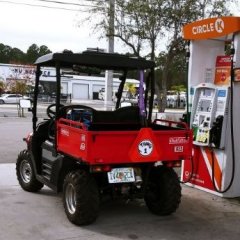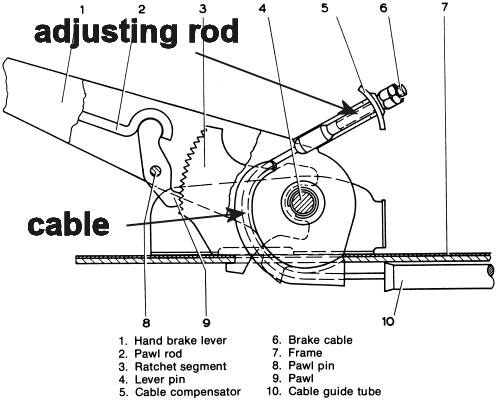-
Posts
350 -
Joined
-
Last visited
-
Days Won
49
Content Type
Profiles
Events
Forums
Gallery
Downloads
Community Map
Everything posted by cliffyk
-
Unless Hisun has dramatically changed the rear reducer on the 2019 Outfitter 550 it remains that it is NOT a differential at all, but rather a "solid" , "spooler" type gearbox--it has no "differential". This i the latest (2018) diagram I have: Due to the narrow rear track no "differential proper" is needed--it would just add complication with no benefit--and in fact reduce traction in 2WD mode... Post a photo of your beast's rear end (the UTV, don't get wild on us) and we'll know for sure...
- 1 reply
-
- coleman 550
- outfitter
-
(and 1 more)
Tagged with:
-
Bombadier, Artic-Cat and Polaris are names cemented in my mind due to growing up in Maine--in the 50s and 60s those names were synonymous with "snowmobile". IMHO, however like most older well established "leaders" in the vehicle industry they fell back and sat on their fat laurels while the Japanese and Asians took over market share with both price and quality. The Asians now dominate the market for recreational vehicles--this is best evidenced by all three of the above named brands now having Asian produced vehicles in their "line-ups". The Asian makers are doing to the Japanese recreational vehicle industry just what the Japenese automotive industry did to the American auto industry (another example of sitting on their fat laurels while the world passed them by (most 70s and 80s US cars were absolute crap). The early Jap cars were the "Yugos" of the day--I remember a neighbour buying a 1958 Toyota Crown. it was the joke of the neighbourhood. But, the Japs, like all Asians, are a proud people and their response to the laughter was to build better cars. The US auto industry is a small fraction of what it was in 1960. But I digress (as I am wont to do); getting back to the OP's concern, buying used is always a "pig-in-a-poke". something I almost never recommend to those like my step-son-in-law who has an almost negative mechanical aptitude and intuition. If however you are the sort that can diagnose and repair the typical problems that all used machines carry with them then go for it--you wil likely save a bunch of money but remember to keep some of those savings reserved for when the machine does break--and it will, they all do, even new ones. Until rather recently I had no involvement with ATVS, UTVs and the like; though I've ridden motorcycles since I was 13 (some 61 years ago). After-sale warranty support on bikes is terrible, generally blank stares and long waits for "the factory" to respond. My impression of the ATV/UTV industry (largely through forums such as this, and online reviews, is that it (the ATV/RTV industry) carries this to new lows. So my bottomline advice to the OP is: Drive, and quite thoroughly listen to and inspect, that 2012 RZR. If you do not feel comfortable in assessing it's condition then find someone who does and bring them with you. Listening to it is vital--all machines will tell you when something isn't right but you need to be listening. My grandfather (The Scot Steam Engineer) always defined mechanical aptitude as the "...ability to listen to a machine that you have never seen or heard before and determine if it is operating properly." Be extremely critical of any shortcomings or perceived issues--no matter how trivial. Use them as negotiating terms to get the best price. Remember at all times that "The last time any machine starts and runs properly may well have been THE last time it will start and run properly." (again my grandfather's words)--this holds true for ANY machine, new or used. -cliff-
-

Fuel Pump Intermittently Priming (solved)
cliffyk replied to Rustynutzz's topic in Massimo UTV SxS Forum
The fuel pumps on these vehicles are generally prettuy stupid devices, their only job is to keep fuel line pressure around 43.5 psi (3 bar¹). When powered up they just run 'til the line pressure is as desired then shut down until the pressure falls as the engine consumes fuel. They are not intelligently monitored or commanded. by the ECU--they just do their thing if there is sufficient pressure in the line when powered up they will not run, I think this is what you are observing. To test it you'll need to monitor the fuel pressure and make sure the pump runs when the pressure is less than 30 psi or so. Or divert the fuel line to a container and make sure the pump runs continuously with the key on--be careful though, at 40 psi gasoline can spray everywhere. How many cc is your t-boss? As a 2020 it is a LInhai under the Massimo badges--I do not have much info on the Linhai machines yet. However the fuel pump relay is likely a little black box in the fuse block. ------------------------------------------------------ ¹ - 3 bar (43.5 psi) is the pressure standard for fuel injector capacity ratings--most vehicle makers supply them with that pressure. -
Long intro--bear with me... I have come to realize that if I get 3500-4000 miles out of the OEM Wanda tires on my 2020 Hisun HS400 I will be doing quite well--I suspect this is due in large part to my being able to get it registered as fully "street legal" (in Florida) and use of that status to make trips to the gas station/beer store (2 miles West) ) and the beach (2 miles East) on a paved road (Florida State Road 206). Going to the beer store I have to straddle the right-of-way with two wheels on the pavement--going to the beach I am right on the road at 40-45 MPH. In any event, at 620 miles I have already shaved 3/32" or so off the tread. So, while cruising Craigslist I found a fellow sellin g brand new set of tire and wheels, take-offs from his son's new 2021 Honda Rubicon¹. A set of Maxxis OEM 25x10-12 and 25x8-12 tires just as I will need, on 4x110 bolt pattern wheels--for just $125. The only quirk was that the offset on he rear wheels is about an inch shy of what my HS400 wants--no problem says I , that's why God invented wheel spacers. So, next mission was to cruise Amazon and see what Prime could bring me--so I found a pair of 1" spacers for just $34 w/tax & shipping from some outfit calling themselves Freedom County ATV. The only issue was their crappy ad copy made no mention of stud size, just bolt circle--but as a Prime member I'll just send ;em back if they are not M10 x 1.25--it will be on the vendor's dime. Got them today, they are M10 x 1.25 and are very well made--nicely machined and the fit and finish are great, the studs are marked ass being metric class 12.9, best their is. ------------------------------------------- ¹ - The kid of course,--being a kid--had to run out immediately, empty his bank account and screw up the new toy's suspension with a "lift-kit" and bigger wheels and tires. Anyway, here's my Amazon review: ----------------------------------------------------------------------------------------- Got these today (2nd day delivery) and was very pleased with their fit, finish, and value--the reason for my 1 star rating is to see if I can get someone's attention re: their crappy ad copy--specifically absolutely NO mention of the stud size-- which is (drum roll please) M10 x 1.25. This is a VERY critical specification and the vendor's not listing same, and other critical dimensions, is inexcusable. I fiddled around the web for a couple of days attempting to determine the stud size (even left a message on Freedom County's website via their "Contact Us" online form--with no response > 48 hours later. I.e. do not expect much support from these people. I ordered them anyway thinking if they do not fit WTF, it's Prime I'll just send 'em back--which would be very unfortunate as it would waste everybody's time & money (time only for me). This in unfortunate as the product is top notch and a great value. The M10 x 1.25 studs are marked as being metric class 12.9 strength, the highest their is--and greater than SAE Grade 8. I have included other dimensions on the attached photos. They are not "hub-centric" on my Hisun HS400, however the base of the mounting nut bores are conical, matching the provided nuts; so they aligned nicely. Again, I do recommend these spacers but it remains lamentable that he vendor did not provide complete specs and has no other method of contact other that their online contact "form" (annoying and silly things that seem rarely responded to). BTW--turns out that the stud size is mentioned (just "mentioned" by another customer, not specified) in the 16th or 17th customer question. ----------------------------------------------------------------------------------------- I do recommend them despite there likely being NO customer support--as these are just a $34 "either they work or they don't" product that doesn't really matter... A final note. In playing about with all of this I found that the HS400 has a 44." front track, and 41" track at the rear? This may explain the odd squirmy tracking I have experienced in heavily rutted soft sand at he beach. I think I will install the spacers with the stock rear wheels to get a 43" track at he rear and see if it improves the tracking on the sand. If it does I will likely need to get a set of 2" spacers when I install the Rubicon wheels and tires--but the ding-dong outfit (Freedom County ATV) sells 2" spacers too...
-

Buying my first UTV soon. Need some advice
cliffyk replied to WVMan's topic in UTV General Discussion
Con for both: Way the heck out of my "retired and living longer than I thought toy budget". -

Buying my first UTV soon. Need some advice
cliffyk replied to WVMan's topic in UTV General Discussion
"limited to the two dealers in my town" means limited to what they sell. So, pIck one. They are both good machines--personally I'd go with the Kawasaki--don't really know why except that I've had three Kawasaki bikes and they all just ran, and ran, and ran.., I put 90k miles on a 1988 1500cc (actually 1450 cc, 88 in³--I.e. an '88 88) Vulcan I bought when I had to sell my pristine '68 dresser to buy my house back from my ex... -
I think I've got it--drove 10 miles or so today, using reverse 4 or 5 times--only once did it whiz, clank, clunk. I have found that shifting while the vehicle is just slightly in motion, or has been stopped for a bit (15-30 seconds), makes it better--also, shift to reverse and wait 5-10 seconds before hitting the throttle...
-
But, they always work best when they are good and tight...
-
Random almost always = loose/corroded or otherwise poor connection, mechanical things (switches, relays, solenoids. etc.) usually either work or they don't.
-
After using the Coleman position, but using reverse as the basis, point it was better--however it was getting the back wheels wheels up and final tweaking that git it dialed in. The setting is much more finicky than I would have expected. Before pestering Coleman for their recommendation I had devised my own procedure that worked OK using the neutral gate s ground zero and adjusting the cable til forward and reverse were equally offset from neutral--, but using reverse seems to work better. I always find it helps to know what you are doing--this is the transmission configuration (note the components are not shown in their normal alignment, this is a common annoyance in Asian power transmission diagrams): The main (input) shaft is at the top--it is powered by the CVT driven sheave and drives the middle (counter) shaft in two ways. One is a chain drive (reverse)--'tother is a gear drive (forward). A sliding cogged shifting collar is what connects either the reverse driven chain sprocket or forward driven gear to the counter-shaft. It is the lateral position of that collar that we are adjusting. Here is the entire forward/reverse sprocket/gear/collar assembly: The collar is splined to the shaft,but free to move laterally. The reverse sprocket and forward gear are free to rotate on the shaft until engaged by the collar's cogs. Note that he cogs on the "forward" end of the collar are angled outward at their end, while the "reverse" end cogs are straight (or less angled). I guess this was done to ensure forward was a good solid engagement. However it seems to be what makes reverse engagement fussy. The reverse driven sprocket rides on a roller bearing on the shaft, the forward gear does not. this is solid design as the reverse sprocket spends most of it's life rotating in the opposite direction of everything else. In "forward", the forward gear rotates with the shaft--no bearing is needed. For completeness here's the reverse chain, a solid, robust so-called "silent" chain:
-
Is this a trick question? It's like asking "How do you avoid sand at the beach?" You don't...
-
FWIW, I did not find this to work. I had been having problems with delayed shifting into reverse (whizzing, clanking and finally clunking into gear) and followed the instructions to the letter to find it would not shift into reverse at all. So, as reverse gear was my problem I "reversed" Coleman's procedure (no pun intended)--I used reverse as the basis point: altering step 5. to push the shift linkage away from the engine (reverse), and then doing all the rest but placing the shift lever in the reverse position to adjust and reconnect the cable. This worked, but i still tweaked it a bit to get it as smooth as i wanted. I jacked up the back end (wheels off the ground, parking brake off) and alternated between forward, neutral and reverse, spinning the driver's side back wheel and tweaking the shift cable adjustment until it was obvious each gear (F & R) were ebgaging as positively as they could. Never had a problem with forward, just reverse. I next started the engine (still jacked up, p-brake off--be CAREFUL HERE!!!) and did some final tweaking (1/4 to 1/2 turn of the adjusting nuts) 'til I was happy. I now have nice, positive shifts into reverse--no whizzing, clanking or clunking...
-
I understand, I owned nothing but manual transmission vehicles for 45+ years--a stroke in late 2011 changed that--got my first auto, a 2012 Infinity M37; still have it, best car I have ever owned...
-
It looks like there's maybe 1/2" and a bit of adjustment--wonder what is supposed to keep that barrel nut on there? Ii you get some exposed thread when you tighten it see if you can get a lock nut on the rod--looks like an M5 or M6 thread. If you can find it, the other end of the cable with the longer threaded rod would offer more adjustment--it has to be at the operating lever end... On the new cable it looks as though the end of the threaded extension mat be upset a bit:
- 45 replies
-
- e-brake
- hand brake
-
(and 1 more)
Tagged with:
-
Getting back on track, how are you doing with that parking brake? If you can post photos of what you can see, I'd love to have a look at 'em...
- 45 replies
-
- e-brake
- hand brake
-
(and 1 more)
Tagged with:
-
That's just how my brain works too...
- 45 replies
-
- 1
-

-
- e-brake
- hand brake
-
(and 1 more)
Tagged with:
-
They know that, hat's why they sell them as Hisun USA, Inc.
- 45 replies
-
- 1
-

-
- e-brake
- hand brake
-
(and 1 more)
Tagged with:
-
They would cost more to make (this is a very competitive cost driven industry) and there is little to no demand. Personally I think the CVT is better suited to off-road use.
-
I think it wise to avoid a relationship with Massimo, they seem to care most about their interests. I don't know if Hisun is seeking vendors, but you might want to consider that. My HS400, which I bought as a Coleman UT400, seems to be quite well made; and looking at the model's history there appears to be a record of constant improvement. The engine in mine is both water and oil cooled, it also uses forced air cooling of the magneto. I found through the EPA data that the chassis, bodywork and suspension were made by the Vietnamese company--into which they installed the Hisun produced engine and drive train. The welds, obviously machined generated, are textbook perfect, alignment and all is spot on.
- 45 replies
-
- e-brake
- hand brake
-
(and 1 more)
Tagged with:
-
My 400 will steer OK in 4WD on more firm surfaces, even a sandy road, but on the beach in the deep, fine, soft sand we have due to beach "replenishment"¹ it wants to squirm all over the place. Not a real problem but disconcerting and annoying when suddenly the vehicle rotates 5° to 10° by itself--it doesn't really turn, just rotates and ends up pointing in a different direction. ------------------------------------------------- ¹- Replenishment = pumping very fine sand from the ocean floor 1/2 to 1 mile out onto the beach. It is NOT normal beach sand, more like a powder; it blows all over the place, we now have 20-30+ foot high dunes where 25 years ago there were none. A typical Government "good intention" not thought through all the way and gone wrong in the end.
- 45 replies
-
- e-brake
- hand brake
-
(and 1 more)
Tagged with:
-
I remember the dinosaurs too... I had a chain drive pedal driven tricycle when I was a kid, that would flip easily in a turn too. Re; "floating", that's what my HS400 does on the beach., we have designated driving areas between the dunes and the beach proper that get significantly rutted up from the heavier, wider track vehicles--my little 1100 lb. UTV get two wheels in a rut and two wheels floating on the mound between the ruts; and cannot make up it's mind which way to go. 2WD is better than 4WD if I don't need the extra traction. 4WD with the front diff locked is horrible, grabbing and turning every which way, tossing the back end around.
- 45 replies
-
- 1
-

-
- e-brake
- hand brake
-
(and 1 more)
Tagged with:
-
I got in a discussion on linked-in about my early cgriatmas present to myself (my HS400)--the discussion broadened as they do on that forum and a couple of fellows in the RV industry got invilved. They said it was well known in the "industry" that Chongqing Huansong Science and Technology Industrial Co., Ltd. (Hisun) dumped Massimo in 2018--having become fed up with their poor quality control and customer service. Your experience with them bears out Hisun's concerns, and the EPAdata (see a clip below) illustrates Massimo's marketing of Chongqing Huansong (Hisun) manufactured vehicle from 2010 through 2018--when they abruptly switched to a variety (four to be specific) of other Chinese and makers--selected I am sure by cost, not quality. Massimo likes to bill itself as a "builder" (implying "manufacturer") of recreational vehicles--however in reality they are an assembler and vendor of kits they buy from various manufacturers; they assemble as required and carefully place their brand stickers on the stuff they slap together.. They do not "make" anything any more than I "made" Mr. Machine when I was seven. I would not have expected installation of parking brake pads to be part of Massimo's assembling the vehicle, but who knows, they may have saved 50¢per unit by buying them very completely disassembled--or maybe Hisun screwed up. My HS400 is vert well made, green paint daubs on everything that had to be installed/torqued. Last Fall my daughter bought a "some assembly required" 4' x 8' Folding utility trailer from Harbor Freight--what she got was two large boxes, one containingthe axle and wheels, the other containing steel panels and angle iron--AND a 25 lb. plastic bag of 893 million nuts & bolts. Fortunately the grand-kid was there to help the geezer. I never before thought I could get tired of screwing--"some assembly required" my backside...
- 45 replies
-
- 1
-

-
- e-brake
- hand brake
-
(and 1 more)
Tagged with:
-
That's a lawsuit waiting to happen--get photos of that!
- 45 replies
-
- e-brake
- hand brake
-
(and 1 more)
Tagged with:
-
My father and grandfather were both engineers--my grandfather a "stationary steam engineer" in a mill in Paisley Scotland--I can';t stand broken stuff, even if it's not mine; just the way I was raised. Here's a good sectional drawing of a the hand lever of a typical cable operated hand brake: If you remove the cover on you brake handle you will likely see something like that. It would be the best way of adjusting the free play (likely has a wider range of adjustment too). -cliff-
- 45 replies
-
- e-brake
- hand brake
-
(and 1 more)
Tagged with:
-
I would alter the middle adjustment with the p-Brake handle "off", as you have too much free play you want to lengthen (tighten) he cable sheath which would be loosening the nut near the rubber grommet and tightening the other. Do so until the brake handle is capable of locking up the brake (typically this is when it "clicks: a couple times when engaging. If this is not possible find the end with the long threaded rod and tighten that. I got that from a Chinese supplier we used some years back for machine parts...
- 45 replies
-
- e-brake
- hand brake
-
(and 1 more)
Tagged with:


















